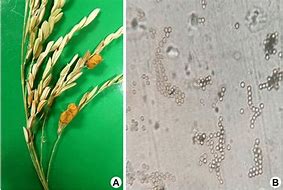User:Cortez10: Difference between revisions
| Line 20: | Line 20: | ||
Rice false smut has a notable impact on rice cultivation, particularly in the regions of China, the United States, and India. (Fan et al., 2016). China is known to tackle an expansive rice false smut disease incidence of 3.06 million hectares of rice fields, which results in an annual yield loss of 158.6 million kilograms. The Yangtze River basin remains a hot spot for rice false smut despite immense efforts between 2008 and 2016 despite attempts to reduce the disease across 6.9 hectares. In these regions, rice false smut incidence in the region continues to persist, ranging from 19% to 40%. India, faces similar struggles of incidence rates in rile tillers that fluctuate between 5% and 85%. These rice tillers are pivotal for grain production because they are susceptible to rice false smut and lead to rice yield loss ranging from 0.2% to 49% (Liu et al., 2023). | Rice false smut has a notable impact on rice cultivation, particularly in the regions of China, the United States, and India. (Fan et al., 2016). China is known to tackle an expansive rice false smut disease incidence of 3.06 million hectares of rice fields, which results in an annual yield loss of 158.6 million kilograms. The Yangtze River basin remains a hot spot for rice false smut despite immense efforts between 2008 and 2016 despite attempts to reduce the disease across 6.9 hectares. In these regions, rice false smut incidence in the region continues to persist, ranging from 19% to 40%. India, faces similar struggles of incidence rates in rile tillers that fluctuate between 5% and 85%. These rice tillers are pivotal for grain production because they are susceptible to rice false smut and lead to rice yield loss ranging from 0.2% to 49% (Liu et al., 2023). | ||
[[File:U.virens.jpg|thumb| | [[File:U.virens.jpg|thumb|600px|right|This image depicts the symptoms and signs of false rice smut caused by "Ustilaginoidea virens" (Cooke) Takah. in the rice panicle of rice plants. In image A the spore galls on panicle are present and in image B Chlamydospores can be seen from asexual reproduction. https://www.researchgate.net/profile/Marco-Maidana-Ojeda/publication/312260540/figure/fig1/AS:450821461680129@1484495620677/Symptoms-and-signs-of-false-smut-caused-by-Ustilaginoidea-virens-Cooke-Takah-in-rice.png]] | ||
==Life Cycle, Cell Structure, Metabolism== | ==Life Cycle, Cell Structure, Metabolism== | ||
Revision as of 09:08, 1 December 2023
Classification
Domain; Phylum; Class; Order; family [Others may be used. Use NCBI link to find]
Species
|
NCBI: [1] |
Genus species
Alternate name(s) of this species
Background and Significance
Rice false smut (RFS) has become a considerable threat to global rice production, exerting a notable impact to affect both yield and grain quality. The fungus Villosiclava virens (V. virens), along with its anamorphic form Ustilaginoidea virens (U. virens), belongs to the Kingdom Fungi, specifically within Phylum Ascomycota and Class Ascomycetes. U. virens, the anamorph form responsible for sexual reproduction, is classified further into Subclass Incertae sedis, Order Incertae sedi, Family Incertae sedis, and Genus Ustilaginoidea. The fungal life cycle involves both asexual and sexual reproduction . The asexual stage (anamorphs) promotes rapid propagation and the sexual stage (teleomorphs) leading to efficient propagation and genetic recombination to generate new strains. The teleomorph form, V. virens, is found in Subclass Sordariomycetes, Order Hypocreales, Family Clavicipitaceae, and Genus Villosiclava, adding layers of complexity to the fungal life cycle (Fan et al., 2016). The flexibility of the fungus to adapt to changing environmental conditions further demonstrates the status of the fungus to cause the disease, rice false smut, to be considered a significant rice pathogen in agriculture production. Rice false smut has a notable impact on rice cultivation, particularly in the regions of China, the United States, and India. (Fan et al., 2016). China is known to tackle an expansive rice false smut disease incidence of 3.06 million hectares of rice fields, which results in an annual yield loss of 158.6 million kilograms. The Yangtze River basin remains a hot spot for rice false smut despite immense efforts between 2008 and 2016 despite attempts to reduce the disease across 6.9 hectares. In these regions, rice false smut incidence in the region continues to persist, ranging from 19% to 40%. India, faces similar struggles of incidence rates in rile tillers that fluctuate between 5% and 85%. These rice tillers are pivotal for grain production because they are susceptible to rice false smut and lead to rice yield loss ranging from 0.2% to 49% (Liu et al., 2023).

Life Cycle, Cell Structure, Metabolism
Genome Structure
Describe the size and content of the genome. How many chromosomes? Other interesting features? What is known about its sequence?
Ecology and Pathogenesis
Habitat; symbiosis; environmental or industrial relevance; contributions to environment.
If relevant, how does this organism cause disease? Human, animal, plant hosts? Virulence factors, as well as host symptoms.
References
Author
Page authored by _____, student of Dr. Marc Orbach, University of Arizona .
